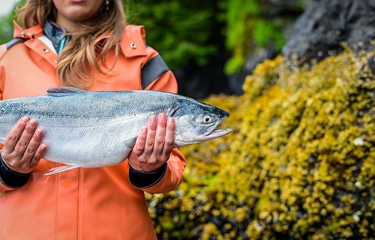The Bristol Bay Regional Seafood Development Association (BBRSDA) and the University of Washington Alaska Salmon Program hosted a webinar on Thursday, 5 May, to present their 2022 salmon forecast for Bristol Bay, as well as ongoing research into run timing, environmental impacts, and fish and climate trends in the bay.
Founded in 2005, the BBRSDA is an organization established by Bristol Bay fishermen to support all aspects of the sockeye salmon fishery, from marketing and infrastructure to research and education. The University of Washington’s Alaska Salmon Program has partnered with BBRSDA to research the Pacific salmon fisheries of Alaska in an effort to gain understanding of the changing ecosystems and provide knowledge necessary to management and conservation.
BBRSDA President Michael Jackson said the partnership has the goal of “translat[ing] scientific research into practical application ... to keep Bristol Bay the most sustainable fishery on the planet.”
UW Project Manager and Research Scientist Chris Boatright said the forecast for the upcoming season in Bristol Bay is the largest ever seen, at 71.91 million fish. This translates to an approximate harvest of 52.4 million fish after accounting for escapement and the catch in Alaska’s South Peninsula. The Nushagak River and Wood River fisheries have been among the highest-producing river systems in recent years and are forecast to perform similarly this year, Boatright said.
However, while runs have been larger in Bristol Bay in recent years, overall salmon returns across Alaska has been down, which Boatright said “generally has to do with very climate-driven growth.”
Daniel Schindler, another researcher with the UW Alaska Salmon Program, said warmer sea surface temperatures that have translated to bigger returns in Bristol Bay “correlate to disastrous returns elsewhere,” referencing the Gulf of Alaska, where the sea surface temperatures are already warmer than those in Bristol Bay. A strong La Niña over the last several decades has been a factor, and combined with climate change, Alaska’s inland water bodies and the Gulf of Alaska have warmed rapidly, Schindler said. Schindler said he wasn’t sure when the rising temperatures would begin to cause a decline in survival rates, as has been seen further south.
These warmer sea surface temperatures have not only been beneficial to the survival rate of the Bristol Bay’s sockeye salmon, but also pink and chum salmon. Many of those fish are hatchery-produced, and the high survival rates of those fish are aiding in a declining average body size of the bay’s sockeye, which has been observed since 1980 and which has accelerated over the past decade, Schindler said.
“We should be expecting a lot of small fish this coming summer,” he said.
UW Fisheries Scientist Curry Cunningham who has been conducting research into the use of machine learning to predict the timing of Alaska’s salmon runs, said high abundance years have typically coincided with later run times, though those have been historically highly variable. Cunningham said he is studying whether or not there are environmental conditions that are linked to run timing, and is also investigating the role of ice pack, precipitation, and sea surface temperature in run-timing estimations. He said his hope is that his research can lead to better estimates of run starts to aid fishermen, canneries, and scientists better prepare for the salmon season.
University of Washington Professor Ray Hilborn, the leader of the UW Alaska Salmon Program, said his recent research has shown the environmental impact of Alaska’s salmon is much lower than many other popular foods in the United States.
“[Alaska sockeye is] one of the most environmentally friendly forms of food that we know,” he said. “A kilogram of sockeye is lower [in impact] than a kilogram of corn.”
Hilborn said the environmental impact of Alaska sockeye salmon is lower than that of Atlantic farmed salmon, as measured in kilograms of CO2 emissions created in the production process to kilograms of product. Most of the difference comes from the carbon impact of the fertilizers, pesticides, and extensive land use needed to produce aquafeed.
Hilborn said other factors in Alaska’s salmon fisheries – from the fishing and production process, to transport, nutrient release, ecotoxicity, and land use – all compare favorably to most other proteins commonly consumed in the U.S. To buttress his point, Hilborn compared a sandwich made from Alaskan sockeye to Burger King’s Impossible Whopper’s in terms of carbon footprint, claiming that the sockeye sandwich had 1.7 kilograms of CO2 output per kilogram of product, versus 3.5 kilograms of CO2 per kilo for the Impossible burger.
Reporting by Kathryn Gill
Photo courtesy of Lusamerica







